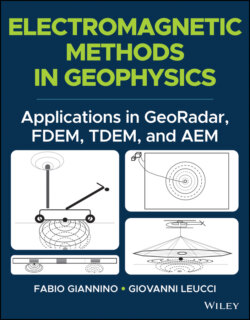Electromagnetic Methods in Geophysics

Реклама. ООО «ЛитРес», ИНН: 7719571260.
Оглавление
Fabio Giannino. Electromagnetic Methods in Geophysics
Table of Contents
List of Tables
List of Illustrations
Guide
Pages
Electromagnetic Methods in Geophysics. Applications in GeoRadar, FDEM, TDEM, and AEM
PREFACE
REFERENCES
ACKNOWLEDGEMENTS
1 Introduction
2 Electromgnetic (EM) Theory: An Outline. 2.1. GROUND PENETRATING RADAR (GPR): OPERATIVE PRINCIPLES AND THEORY. 2.1.1. General
2.1.2. Principles of the Method
2.1.3. Electromagnetic wave propagation
REFERENCES
2.2. FREQUENCY DOMAIN ELECTROMAGNETIC (FDEM) METHOD: OPERATIVE PRINCIPLE AND THEORY. 2.2.1. EM Waves and Fundamental Quantities
2.2.2. The Relation Between the Primary and Secondary EM Field
2.2.3. The “Low Induction Number” Condition
2.2.4. The EM signal with respect to the depth
REFERENCES
2.3. TIME DOMAIN ELECTROMAGNETIC (TDEM) METHOD: OPERATIVE PRINCIPLE AND THEORY. 2.3.1. TDEM (Time Domain Electromagnetic)
REFERENCES
2.4. AIRBORNE ELECTROMAGNETIC (AEM) METHOD: OPERATIVE PRINCIPLE AND THEORY. 2.4.1. AEM (Airborne Electromagnetic)
REFERENCES
3 GPR Surveying. 3.1. GPR: SYSTEMS ARCHITECTURE. 3.1.1. General
3.1.2. Sampling
3.1.3. Resolution
3.1.4. Data Sampling for a Pulsed System
3.1.5. Data Sampling for a Stepped Frequency Georadar System
3.1.6. Antenna Parameters and Radar Equation
3.1.7. The “Minimum” Elements as Essential Parts of a Georadar: Radar Architecture
3.2. SURVEY DESIGN
3.3. DATA ACQUISITION
3.4. DATA ANALYSIS
3.5. DATA INTERPRETATION
REFERENCES
4 FDEM Surveying. 4.1. FDEM SYSTEMS ARCHITECTURE
4.1.1. Transmitter
4.1.2. Receiver
4.1.3. Control Unit
4.1.4. Positioning
4.1.5. Other Parameters
4.2. SURVEY DESIGN
4.3. DATA ACQUISITION
4.3.1. FDEM Data Acquisition Modes
4.4. DATA ANALYSIS
4.5. DATA INTERPRETATION
REFERENCES
5 TDEM Surveying. 5.1. TDEM SYSTEMS ARCHITECTURE
5.1.1. Transmitter
5.1.2. Receiver
5.1.3. Control Unit
5.1.4. Power Supply
5.1.5. Positioning
5.1.6. Other Parameters
5.2. SURVEY DESIGN
5.3. DATA ACQUISITION
5.4. DATA ANALYSIS
5.5. DATA INTERPRETATION
REFERENCES
6 AEM Surveying. 6.1. AEM SYSTEMS ARCHITECTURE
6.1.1. Transmitter
6.1.2. Receiver
6.1.3. Control Unit
6.1.4. Mechanical
6.1.5. Power Supply
6.1.6. Other Parameters
6.2. SURVEY DESIGN
6.3. DATA ACQUISITION
6.4. DATA ANALYSIS
6.5. DATA INTERPRETATION
REFERENCES
7 Case Studies
7.1. GPR: MULTIPLE GEOPHYSICAL ARCHAEOLOGICAL SURVEYS IN TURKEY
7.1.1. Introduction
7.1.2. Geophysical Methods and Instruments
7.1.3. The Martyrium of St Philip
7.1.4. Civil Agora
7.1.5. Sanctuary of Apollo
7.1.6. Gymnasium
7.1.7. Conclusions
7.2. GPR: MASSIVE ARRAY ARCHAEOLOGICAL SURVEY IN ITALY
7.2.1. Introduction
7.2.2. Data Acqusition and Instrumentation
7.2.3. Data Processing
7.2.4. Results and Discussion
7.2.5. Conclusion
7.3. GPR: ARCHAEOLOGICAL AND MONUMENTAL APPLICATION AT A CATHEDRAL IN ITALY
7.3.1. Introduction
7.3.2. GPR Data Acquisition, Processing, and Interpretation
7.3.3. The Crypt
7.3.4. The Cathedral
7.3.5. Conclusions
7.4. GPR: ARCHAEOLOGICAL APPLICATION IN PERU
7.4.1. Introduction
7.4.2. GPR Data Acquisition and Analysis
7.4.3. Conclusions
7.5. GPR: MONUMENTAL HERITAGE CONSERVATION AT A HYPOGEAL SITE IN ITALY
7.5.1. Introduction
7.5.2. Data Acquisition and Processing
7.5.3. Conclusions
7.6. GPR: CONCRETE REBARS DETECTION IN SOUTH‐EUROPE
7.6.1. Introduction
7.6.2. Data Acquisition and Instrumentation
7.6.3. Data Processing
7.6.4. Results and Discussion
7.6.5. Conclusion
7.7. GPR: CONCRETE REBARS DETECTION AND WATER CONTENT ESTIMATE IN ITALY
7.7.1. Introduction
7.7.2. FIRST Experiment: Relationship Between Volumetric Water Content and Electromagnetic Wave Parameters
7.7.3. SECOND Experiment: Relationship Between Reinforced Bar Diameter in Concrete and Electromagnetic Wave Amplitude
7.7.4. Application of the Experimental Experience: The Case of the Basilica of Santa Croce, Lecce‐ Italy
7.7.5. Conclusions
7.8. GPR: LARGE AREA UNDERGROUND UTILITY MAPPING IN ITALY
7.8.1. Introduction
7.8.2. Data Acqusition and Instrumentation
7.8.3. Data Processing
7.8.4. Results and Discussion
7.8.5. Conclusions
7.9. GPR: UTILITY MAPPING AND FIBRE OPTICS RECONNAISSANCE IN SCANDINAVIA
7.9.1. Introduction
7.9.2. Data Acqusition and Instrumentation
7.9.3. Data Processing
7.9.4. Results and Discussion
7.9.5. Conclusion
7.10. GPR: UTILITY AND CAVITY MAPPING IN TAIWAN
7.10.1. Introduction
7.10.2. Data Acqusition and Instrumentation
7.10.3. Data Processing
7.10.4. Results and Discussion
7.11. GPR: PIPES LEAKAGE DETECTION EXPERIMENTAL TEST AND APPLICATION IN ITALY
7.11.1. Introduction
7.11.2. Description of the Considered Experimental Cases
7.11.3. Results and Discussion. 7.11.3.1. GPR results in EC1
7.11.3.2. GPR results in EC2
7.11.3.3. GPR results in EC3
7.11.4. Conclusions
7.12. GPR: PIPES LEAKAGE DETECTION IN ITALY
7.12.1. INTRODUCTION
7.12.2. Data Acquisition and Results
7.12.3. CONCLUSIONS
7.13. GPR: BRIDGE DECK STUDY IN JAPAN
7.13.1. Introduction
7.13.2. Data Acqusition and Instrumentation
7.13.3. Data Processing
7.13.4. Results and Discussion
7.14. FDEM: UXO SEARCH IN BUILDING AREA IN ITALY
7.14.1. Introduction
7.14.2. Results and Discussion
7.15. FDEM: SEARCH OF VARIOUS OBJECT IN A TEST SITE IN ITALY
7.15.1. Introduction
7.15.2. Results and Discussion
7.16. FDEM: POLLUTANTS SEARCH IN ITALY
7.16.1. Introduction
7.16.2. Results and Discussion
7.17. FDEM: FORENSIC SEARCH IN SOUTH EUROPE
7.17.1. Introduction
7.17.2. Data Acquisition and Instrumentation
7.17.3. Data Analysis and Results
7.17.4. Conclusion
7.18. TDEM: GEOLOGIC MODELLING FOR A REFERENCE SITE IN ITALY
7.18.1. Introduction
7.18.2. Data Acquisition and Instrumentation
7.18.3. Data Analysis and Results
7.18.4. Conclusion
7.19. AEM: GEOPHYSICAL AND GEOLOGICAL MODELLING OF BURIED VALLEYS
7.19.1. Introduction
7.19.2. Data Acquisition and Data Analisys
7.19.3. Results and Discussion
7.19.3.1. AeroTEM modeling
7.19.3.2. VTEM modeling
7.19.4. Conclusion
7.20. AEM: EFFECT OF INDUCED POLARIZATION OVER AEM DATA
7.20.1. Introduction
7.20.2. Methods and Results
7.20.3. Data Acqusition and Results
7.20.4. Discussion and Conclusion
REFERENCES
8 General on Planning and Logistic
8.1. PLANNING A CAMPAIGN AND MOBILIZATION ASPECTS
8.2. SHIPMENT AND CLEARANCE OF SURVEY EQUIPMENT
8.3. MANAGING THE OPERATIVE ASPECTS OF THE FIELD ACTIVITY
8.4. DE‐MOBILIZATION
8.5. REPORTING
INDEX
WILEY END USER LICENSE AGREEMENT
Отрывок из книги
Fabio Giannino
.....
When an alternating current flows within the transmitter coil, to this electric current is associated a magnetic field which, in turn, induces eddy current, in the subsoil; to the eddy currents, as in the case of the primary field, is associated a secondary magnetic field, that is sensed (detected) by the receiver coil, together with the primary magnetic field due to the primary electric field.
The secondary magnetic field, is a complex function of the transmitting and receiving coils spacing (s), of the transmitter frequency (f), and of the subsoil conductivity σ.
.....